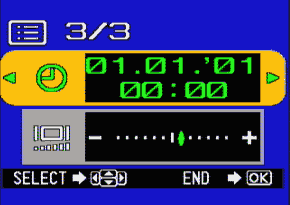Olympus Camedia C-1 Digital Camera
|

This is a quite pretty baby with a 1.31 Megapixel matrix. Its small
dimensions allows you to hold it in a pocket or in a dolly-bag. For today
this is a rather simple camera which is convenient to be always at hand
to fix all interesting events. The camera is switched on by moving off
a lid on the lens. Shooting is easily made with one hand. But additional
control buttons such as for navigating the menu are located on the left,
and, therefore, intended for the other hand. It might have been more convenient
to locate them also on the right to release the second hand. But such layout
had its own advantages: you will not press them accidentally during the
shooting. 
The camera is equipped with a lens with a constant focal length equal
to 4.5 mm and 1/ 2.8 aperture ratio. It also has an optical viewfinder
and an LCD display. The latter is immovable, and it is hard to distinguish
anything on it when sun rays get on it. The camera is connected to a computer
via a USB port. There is a video-out and a connector for an external power
supply unit. The camera is powered by two AA rechargeable batteries or
alkaline cells, or from a proprietary Li battery OLYMPUS CR-V3.
All possibilities of a camera control are demonstrated on the menu below:    
A compression degree, the number of frames remained, a flash mode
and digital enlargement are displayed on the screen during the shooting.
As for a visual angle, the lens is equivalent to a 35mm one for a camera
for 35mm films. In my opinion, it is too wide-angle lens. It should be
noted that a rated lens for the given camera is that with a focal length
meeting the conditions of a natural prospect. Photos are perceived naturally
only if an eye sees an image at the same angle as the object. But on the
other hand, tastes change, and today a lot of simple auto cameras have
short-length lenses. New criteria for choosing the definite lens must be
backed by weighty arguments, which are absent in case of digital cameras,
since a 1.3 Mpixel matrix gives a low resolution as compared with a film,
and the camera is virtually intended for shooting close-ups and not for
a great deal of tiny objects, which get in the field of vision of a wide-angle
lens.
The camera is perfectly deals with shooting panoramas, and althogh the
matrix is not too big, we can get quite large shots by seaming several
frames together. 
To estimate the progress made by digital cameras during the last several
years let's compare shots of our baby with those made with the advanced
camera KODAK DC-120 4 years ago with almost the same matrix.
The DC-120 has significantly more possibilities, and the quality is
the same as of the simple C-1.

The camera is completely automatic, but it handles special shooting
modes quite good, including the macro, as you can see on the photos. 
Fragment 
A diminished photo. Click to enlarge for 1:1.
On the whole, the camera is a classical sample of a digital auto camera
class. And it is hard to expect something more of such a compact device.
It is possible that cameras of this class won't anymore undergo severe
changes since a 1.3- Mpixel matrix is more than enough for the most of
purposes. And compactness and a possibility not to think while shooting
are the right things a consumer wants.
Technical characteristics
| Memory card |
3.3V SmartMedia (4,16.32, 64, 128 MB) |
| File format |
JPEG (DCF), DPOF support |
| CCD |
1/3.2" CCD with 1.31 million pixels |
| Frame size |
1280X960 (SHQ/HQ), 640x480 (SQ) |
| Lens |
F= 4.5 MM, F:2.8 (35 mm in 35mm equivalent), 6 lenses in 5 groups (2
aspheric lenses) |
| Digital enlargement |
1X - 2X |
| Focusing |
TTL autofocus (contrast definition), 0.5 m - infinity, macro - 10-50
cm |
| Exposure control |
Auto (TTL),
exposure correction +-2EV |
| White balance |
Auto, day light, cloudy, incandescent lamps, fluorescent lamps. |
| Viewfinder |
Optical, LCD display |
| LCD display |
3.8 cm color TFT, 113000 pixels |
| Flash |
Built-in, 4 operating modes, 0.2-3.5m range |
| Series shooting |
Up to 4 shots at 2 fps |
| Connectors |
External power supply unit, USB, video-out (PAL) |
| Power source |
Li batteries .CR-V3; 2XAA cells, AC adapter |
| Dimensions |
110X62X34 mm |
| Weight |
165g (without batteries and SM card) |
Write a comment below. No registration needed!
|
|
 |
|
|
|










